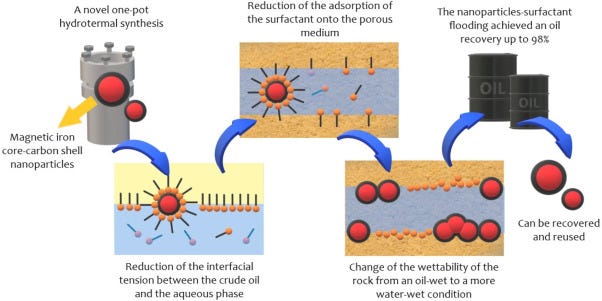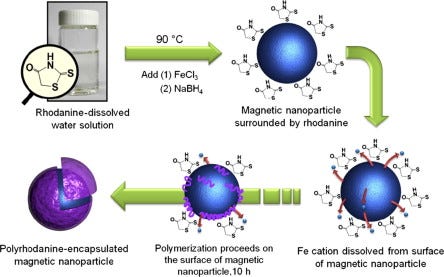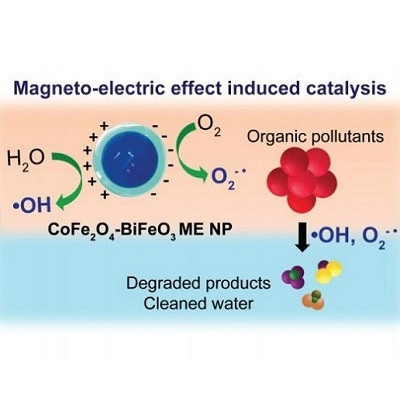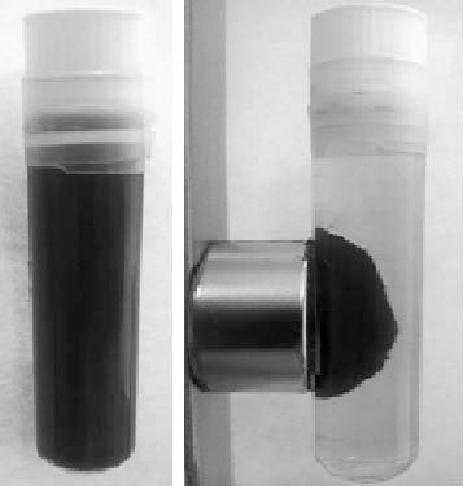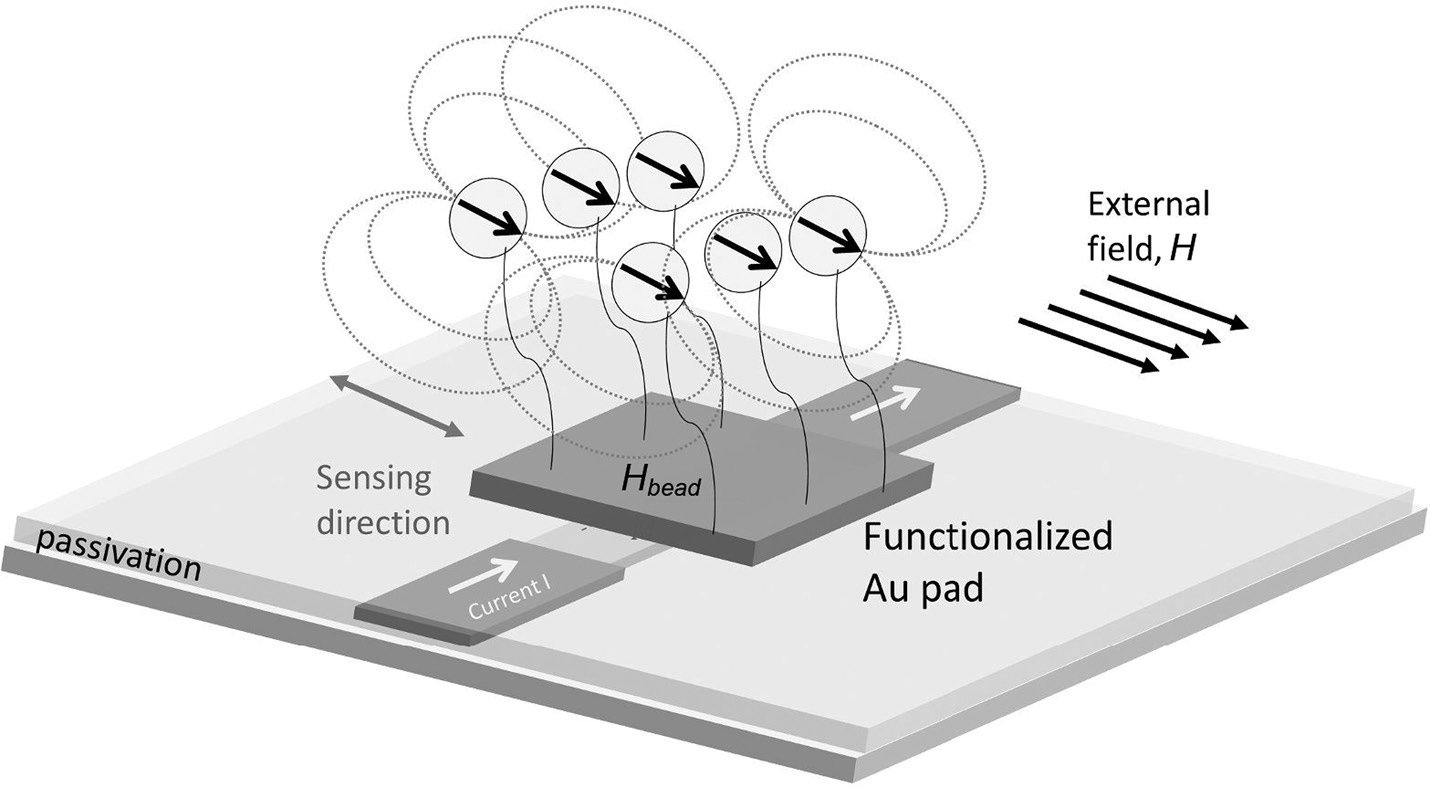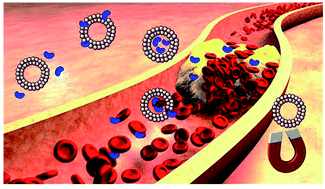Industrial applications
Magnetic iron oxides are commonly used as synthetic pigments in ceramics, paints, and porcelain. Magnetic encapsulates may find very important uses in many areas of life and also in various branches of industry. Such materials are interesting from both points of the fundamental study of materials science as well as their applications. Hematite and magnetite have been applied as catalysts for a number of important reactions, such as the preparation of NH3, the desulfurization of natural gas, and the high-temperature water-gas shift reaction. Other reactions include the Fishere-Tropsch synthesis for hydrocarbons, the dehydrogenation of ethylbenzene to styrene, the oxidation of alcohols, and the large-scale synthesis of butadiene.
Image Courtesy. Zhen Huang (School of Electrical and Electronic Engineering, Wuhan Polytechnic university, Wuhan 430023, People’s Republic of China)
Environmental applications
A similarly important property of nanoscale iron particles is their huge flexibility for in situ applications. Modified iron nanoparticles, such as catalyzed and supported nanoparticles, have been synthesized to further enhance their speed and efficiency of remediation. In spite of some still unresolved uncertainties associated with the application of iron nanoparticles, this material is being accepted as a versatile tool for the remediation of different types of contaminants in groundwater, soil, and air on both the experimental and field scales . In recent years, other MNPs have been investigated for the removal of organic and inorganic pollutants.
Image Courtesy. Andrew Pratt (Department of Physics, University of York, York, United Kingdom)
Organic pollutants
There are a few articles about the removal of high concentrations of organic compounds which are mostly related to the removal of dyes. The MNPs have a high capacity in the removal of high concentrations of organic compounds. Dyes are present in the wastewater streams of many industrial sectors such as in dyeing, textile factories, tanneries, and in the paint industry. Therefore, the replacement of MNPs with an expensive or low efficient adsorbent for treatment of textile effluent can be a good platform which needs more detailed investigations.
Inorganic pollutants
A very important aspect in metal toxin removal is the preparation of functionalized sorbents for affinity or selective removal of hazardous metal ions from complicated matrices. MNPs are used as sorbents for the removal of metal ions. Thus, MNPs show a high capacity and efficiency in the removal of different metal ions due to their high surface area with respect to micron-sized sorbents. These findings can be used to design an appropriate adsorption treatment plan for the removal and recovery of metal ions from wastewaters.
Image Courtesy. Tito Trindade (Department of Chemistry-CICECO, University of Aveiro, 3810-193 Aveiro, Portugal)
Analytical applications
1. Fluorescence techniques. Due to their small size, magnetic luminescent NPs offer a larger surface area-to-volume ratio than currently used microbeads, which result in a good reaction homogeneity and faster reaction kinetics.
2. Encapsulation of magnetic nanoparticles in polymeric matrixes. Encapsulation of inorganic particles into organic polymers endows the particles with important properties that bare uncoated particles lack.
3. The iron oxide nanoparticles are formed by the coprecipitation reaction of ferrous and ferric salts with inorganic bases. A strong base, NaOH, and a comparatively mild base, NH4OH, have been used with each surfactant to observe whether the basicity influences the crystallization process during particle formation. All these systems show magnetic behavior close to that of superparamagnetic materials. By using this method, magnetic nanoparticles as small as 1 to 2 nm and of very uniform size (standard deviation less than 10%) have been synthesized. A uniform silica coating as thin as 1 nm encapsulating the bare nanoparticles is formed by the base-catalyzed hydrolysis and the polymerization reaction of TEOS in the microemulsion. It is worth mentioning that the small particle size of the composite renders these particles a potential candidate for their use in in vivo applications.
Magnetic separation
Properties and Applications of Magnetic NanoparticlesIn a biomedical study, Isolation and separation of specific molecules including DNAs, proteins, and cells are prerequisites in most fields of biosciences and biotechnology. Among various bioseparation methods, magnetic nanoparticles based bioseparation is mostly documented and widely used due to its unique magnetic separation mood and promising efficiency. In the process, the biological molecules are labeled by magnetic nanoparticles colloids and then subjected to separation by an external magnetic field, which may be applied for cell isolation, protein purification, RNA/DNA extraction, and immunoprecipitation.
Magnetic nanoparticles particles such as beads have been extensively used for separation and purification of cells and biomolecules, due to their small size, promising separation mood, and good dispersibility. One of the trends in this subject area is the magnetic separation using antibodies conjugated with beads to provide highly accurate antibodies that can specifically bind to their matching antigens on the surface of the targeted sites.
Diagnostics
Non-invasive imaging methods have been developed by labeling stem cells using magnetic nanoparticles. Among them, Magnetic Resonance Imaging (MRI) is widely used as diagnostic tools to present a high spatial resolution and great anatomical detail to visualize the structure and function of tissues. Several kinds of magnetic nanoparticles have been developed to improve contrast agents in MRI imaging, with significant benefits of improved sensitivity, good biocompatibility and ready detection at moderate concentrations.
Image Courtesy. Wolfgang Tremel (Institut für Anorganische Chemie und Analytische Chemie, Johannes Gutenberg-Universität, Duesbergweg 10-14, D-55099 Mainz, Germany)
Sensors
Many types of magnetic nanoparticles-based biosensors have been surface functionalized to recognize specific molecular targets, due to their unique magnetic properties which are not found in biological systems. Due to different composition, size and magnetic properties, magnetic nanoparticles can be used in a variety of instruments and formats for biosensing with an enhancement of sensitivity and the stability.
Image Courtesy. Nicholas J. Darton, Adrian Ionescu, University of Cambridge, Justin Llandro, Tohoku University, Japan
Drug delivery
Magnetic nanoparticles have been developed and applied in localized drug delivery to tumors. The magnetic nanoparticles first act as a carrier of the drug, which are attached to its outer surface or dissolve in the coating. Once the drug coated particles have been introduced into the bloodstream of the patient, a magnetic field gradient is created by strong permanent magnet to retain the particles at the targeted region. Moreover, magnetic nanoparticles coated with a drug could be injected intravenously, transported, and retained at targeted sites, which make them highly promising system for drug delivery.
Magnetic nanoparticles with various shellsMagnetic nanoparticles with various shells
Therapy
Magnetic nanoparticles have currently been explored as a technique for targeted therapeutic heating of tumors, which is called hyperthermia. Various types of superparamagnetic nanoparticles with different coatings and targeting agents are used for specific tumor sites. Magnetic particle heating can be accomplished at depths necessary for treatment of tumors located virtually anywhere in the human body. In addition, magnetic nanoparticle hyperthermia can also be used as an adjuvant to conventional chemotherapy and radiation therapy, which shows great potential.
Don't hesitate to subscribe if you haven't already done so.
Regards and take care.
Born in 2012, Scixel is a project devoted to the improvement of the scientific comunication through the creation of graphical products: pictures, animations, graphs, posters, etc. Scixel consists of scientists with a deep knowledge in digital graphics but also with a long experience in giving talks, preparing posters and papers and other daily situations of scientific work.
We have focused our work into universities and research institutes all over the world: TuDelft (The Netherlands), NIMS (Japan), Basel University (Switzerland), Universidad Autónoma de Madrid, CNB or ICFO (Spain), to name a few.
Web: https://scixel.es/
If you are a company or an individual who would like to place your advertising in my newsletter you can contact me (email) and let me know your request of type of ad and number of newsletters you would like to place it. I will send you a budget as soon as possible.



